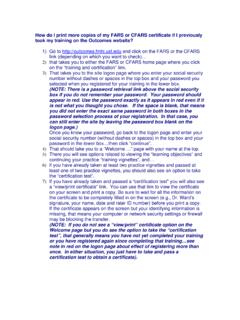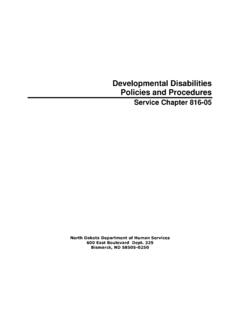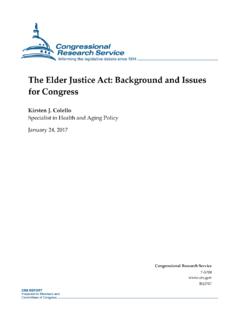Transcription of Children’s Functional Assessment Rating Scale
1 Children's Functional Assessment Rating Scale John C. Ward, Jr., Michael G. Dow, Teri L. Saunders, Shawn C. Halls, Kathy F. Penner, Kristina A. Musante, Ray T. Berry, Natalie Sachs-Ericcson, Department of Mental Health Law and Policy Florida Mental Health Institute University of South Florida Tampa, FL. Original Publication date: October, 1999, with Text Revisions August, 2004 and May 2006. TABLE OF CONTENTS. Development of the Children's Functional Assessment Rating Scale CFARS) ..1. Other State's use of the CFARS 1.
2 Reliability of the CFARS .2. Validity of the CFARS Domains 3. Most recent version of the Florida version of the CFARS Rating form ..5. Instructions for using the free CFARS Internet based Training and Certification System .7. What is an Official CFARS Rater Identification number?.. 10. General Guidelines for Determining Severity Ratings for CFARS Functional Definitions and Behavioral Anchors for the 16 CFARS Functional Domains .14. Depression 14. Anxiety .. 15..16. Thought .17. Cognitive 18. 19. Traumatic 20.
3 Substance 21. Interpersonal Behavior in "Home" Setting .. 23. ADL Work or Danger to Danger to Security Management Using Completed CFARS Ratings to Develop Individualized Treatment/Service/Recovery Plans to Monitor Functional Change/Improvement ..30. Factor Analysis of the 16 CFARS Domains .. 35. Clinically Derived Scales for the 16 CFARS 36. References ..38. Development of the Children's Functional Assessment Rating Scale (CFARS). Introduction In October of 1993, the District 7 Alcohol, Drug Abuse and Mental Health (ADM) Program office of the Florida Department of Children and Families (then called the Department of Health and Rehabilitative Services) entered into a collaborative agreement with the Louis de la Parte Florida Mental Health Institute (FMHI) at the University of South Florida in which FMHI would assist the District 7 Alcohol, Drug Abuse and Mental Health (ADM)
4 Program office in developing procedures to evaluate the effectiveness of their publicly funded mental health and substance abuse treatment services for children and adults. As part of this project, FMHI staff developed the Functional Assessment Rating Scale (FARS). The FARS was adapted from the Colorado Client Assessment Record (CCAR), which had an extensive history of use in evaluating behavioral health services. The FARS was designed to document and standardize impressions from clinical evaluations or mental status exams by recording information on an individual's current cognitive and behavioral (social and role) functioning.
5 (Ward et al., 1995 &. Dow et al., 1996). In Fiscal Year 1995-1996, Florida's Department of Children and Families' (then called Department of Health and Rehabilitative Services) in District 7 (four counties around Orlando), with assistance from FMHI, implemented the Functional Assessment Rating Scale (FARS) to evaluate effectiveness of all state contracted mental health and substance abuse services for adults in that area. As part of the pilot, FMHI also conducted a survey of clinicians completing the FARS for children in that area.
6 The results of that survey of use of FARS for evaluating children indicated that some changes were needed to ensure an accurate reflection of the specific children's issues believed to be important to children's specialists employed in the public behavioral health system. Feedback from the clinician survey, along with input from a consultant child psychologist and several other licensed mental health professionals (including the first and second author's of the Scale ), were utilized to develop the 17 domains (along with the Children's Global Assessment Scale ) that were included in the first version of the Children's Functional Assessment Rating Scale (CFARS).
7 The concept behind the development of the CFARS was to have a single instrument that could: 1) gather Functional Assessment information for domains relevant for evaluating children, 2). gather Florida's societal outcome data elements that were needed to meet Performance Based Planning and Budgeting (PB2) initiatives required by the legislature, 3) provide information helpful to clinicians and agencies delivering services ( , assist in treatment planning and quality improvement monitoring), and 4) be flexible to describe changing status in aggregate reports of Florida's children in care that would reliably inform DCF's mandated reports to the legislature.
8 In December 1996, the CFARS was implemented in a four county pilot area (DCF. District 7), and implemented statewide by June of 1997 as part of Florida's Performance Based Planning and Budgeting initiative. Other State's use of the CFARS. Subsequent to development and adoption of FARS and CFARS in Florida, both measures have been implemented statewide in Wyoming, New Mexico and Illinois to evaluate outcomes for general revenue or Medicaid funded behavioral health services. Other areas within and outside of the have also implemented FARS and or CFARS including Malta, where the CFARS is used to evaluate improvement in functioning of children enrolled in government funded residential services.
9 There is a free Internet web site where additional information, form downloads, and on-line training and certification is available for using both the FARS and CFARS ( ). Specific instructions for accessing and using this free site are included later in this manual. Reliability of the CFARS Domains The graph below shows the results of an inter rater reliability study that examined each of the original 17 CFARS domains (there are now only 16) during the early phases of the pilot implementation in DCF District 7.
10 CFARS Interrater Reliability Correlation Coefficients (n=4 7). 0 .9. 0 .8. 0 .7. 0 .6. 0 .5. 0 .4. 0 .3. 0 .2. 0 .1. 0. ty r it y al l AS. v. l ct S lf ol t r e rf ss l s h se ga Re Re gh pe es Ot d ic x ie un En ho b U. pre CG. g P. gr cu Le Hy ou Str m rp gr LF. Sc An Me me Dn Fa Se Su De Th In t Co Dn Tr m AD. Ho As shown in the graph above, fourteen of the seventeen problem severity rated domains showed adequate levels of interrater reliability (r > .5). The four domains with lower levels of interrater reliability were Thought Process , Traumatic Stress , Home Environment and Family Relationships.







